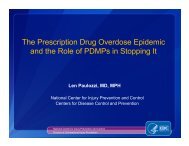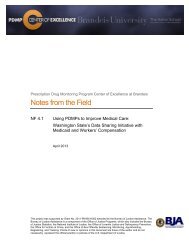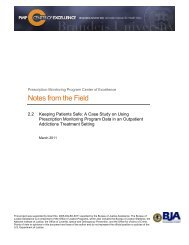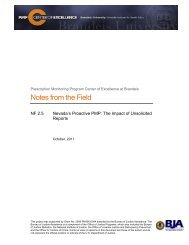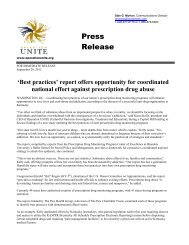<strong>Prescription</strong> <strong>Drug</strong> <strong>Monitoring</strong> <strong>Programs</strong>: An Assessment <strong>of</strong> the Evidence for Best Practices 20Current adoption status: Data quality standards and policies, and procedures in support <strong>of</strong> achievingacceptable data quality, differ among <strong>PDMP</strong>s and likely produce varying degrees <strong>of</strong> success in theirattainment.Barriers to adoption: Barriers to data quality improvement include the cost in staff time <strong>of</strong> surveyingcurrent practices, lack <strong>of</strong> data quality standards, and lack <strong>of</strong> resources needed to update data qualitysystems.SummaryRationale: Complete and accurate data can improve reporting, are important for prescribers andpharmacists making patient care decisions, and can help in detecting questionable activity.Evidence <strong>of</strong> effectiveness: Accumulated field experience, key stakeholder perceptions.Current adoption status: States vary in data quality practices.Barriers to adoption: Cost <strong>of</strong> surveying current practices, lack <strong>of</strong> standards, resources needed to updatedata quality systems.Data linking and analysisBest practices in <strong>PDMP</strong> data linking and analysis will permit better identification <strong>of</strong> unique individuals in<strong>PDMP</strong> data, development <strong>of</strong> standard analyses comparable across states, more reliable estimates <strong>of</strong>questionable activity, more appropriate and applicable epidemiological investigations, expedited andmore reliable analyses, and reports incorporating experienced user knowledge. Candidate practicesinclude actions to:A. Link records to permit reliable identification <strong>of</strong> individualsB. Determine valid criteria for possible questionable activityC. Conduct periodic analyses <strong>of</strong> possible questionable activityD. Conduct epidemiological analyses for use in surveillance, early warning, evaluation, andpreventionE. Develop automated expert systems to expedite analyses and reportsF. Record data on prescriber disciplinary status and patient lock-‐insA. Link records to permit reliable identification <strong>of</strong> individualsRationale and evidence <strong>of</strong> effectiveness: Reliable identification <strong>of</strong> unique individuals in <strong>PDMP</strong> databases,whether patients or prescribers, is vital for accurate analyses and reporting <strong>of</strong> questionable activity andprescribing trends. Although states have implemented a number <strong>of</strong> approaches to link patient records, todate, there has been neither a census taken <strong>of</strong> such approaches, nor an evaluation <strong>of</strong> their effectiveness.
<strong>Prescription</strong> <strong>Drug</strong> <strong>Monitoring</strong> <strong>Programs</strong>: An Assessment <strong>of</strong> the Evidence for Best Practices 21Standard benchmarks for reliable record linking need to be identified against which different linkingalgorithms can be tested. Since the capability to link records belonging to an individual is critical toproviding accurate prescription information to all users and is essential for analyzing the impact <strong>of</strong><strong>PDMP</strong>s, e.g., measuring the level <strong>of</strong> questionable activity, this is an area deserving <strong>of</strong> close examinationfor developing evidence-‐based best practices. See Section V. Summary and Recommendations, below,for further discussion and recommendations.Current adoption status: Many states have developed electronic capabilities to link prescriptionsdispensed to what is likely to be a single individual in cases where the personal identifying informationvaries between records, e.g., the same address and prescriber but a differently spelled first name. Suchlinking is accomplished through vendor proprietary s<strong>of</strong>tware, <strong>of</strong>f-‐the-‐shelf s<strong>of</strong>tware, or in-‐housedeveloped or modified s<strong>of</strong>tware.Barriers to adoption: Barriers to adopting reliable record linking systems include lack <strong>of</strong> standardbenchmarks to assess linking algorithms and lack <strong>of</strong> resources to conduct research to develop standards.SummaryRationale: Reliable linking <strong>of</strong> records maximizes identification <strong>of</strong> unique individuals in <strong>PDMP</strong> data.Evidence <strong>of</strong> effectiveness: Key stakeholder perceptions.Current adoption status: States vary in whether and how records are linked.Barriers to adoption: Lack <strong>of</strong> resources to conduct needed research, no standard benchmarks to assesslinking algorithms.B. Determine valid criteria for possible questionable activityRationale and evidence for effectiveness: Despite the relatively widespread use <strong>of</strong> unsolicited reporting(see User access and report dissemination, E. Send unsolicited reports and alerts to appropriate users,below) on individuals exhibiting possible questionable activity (e.g., doctor shopping), there is littlecommonality in the criteria used by <strong>PDMP</strong>s to identify them. Validated and standardized criteria aretherefore needed to permit reliable identification <strong>of</strong> questionable activity within and acrossjurisdictions. Proactive reporting is also applicable to medical providers who, whether intentionally ornot, may be engaging in risky or illegal prescribing or dispensing behavior. Alerts concerning questionableactivity on the part <strong>of</strong> providers may be appropriately addressed to licensure boards, peer reviewcommittees, third-‐party payers, <strong>Center</strong>s for Medicare and Medicaid Services (CMS), and other bodies oragencies concerned or charged with monitoring medical practitioners. When analysis <strong>of</strong> <strong>PDMP</strong> dataidentifies probable criminal activity, such as prescribing by pill mills, referral to law enforcement agencieswould be appropriate. To guide such alerts, reliable criteria <strong>of</strong> questionable activity byproviders using <strong>PDMP</strong> and other data need research and development; see, for instance, DuBose et al.(2011).Several studies have attempted to shed light on criteria for identifying conditions and behaviors that putpatients at risk for prescription drug abuse. Patients who visit a few prescribers (two to five) in a yearseem not to be more at risk for opioid abuse than those using only one (Wilsey et al., 2011). Studying asample <strong>of</strong> insurance patients on whom they were able to obtain medical records, White et al. (2009)



